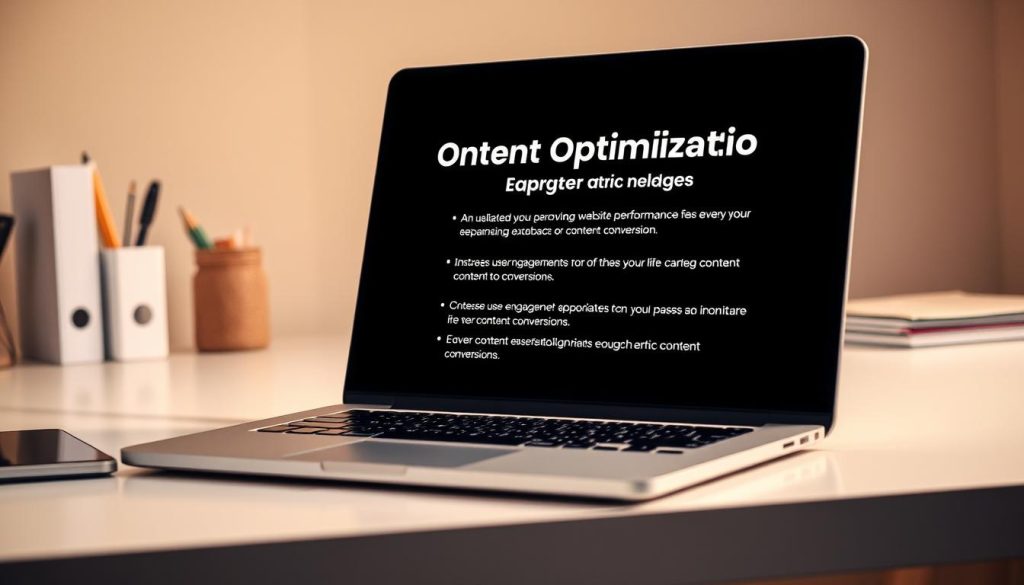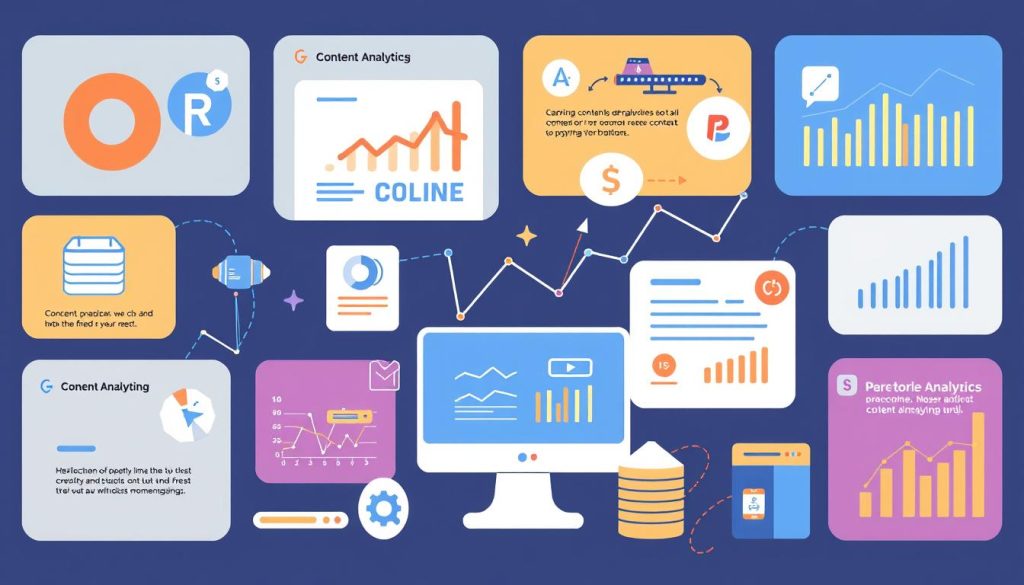In today’s digital landscape, businesses need a strategic approach to stand out and grow. Effective content marketing is at the forefront of this challenge, enabling companies to build meaningful relationships with their audience.
By leveraging blogging as a key component of their strategy, businesses can attract and engage their target audience, fostering trust and driving growth. Our comprehensive guide will walk you through the process of creating a successful content marketing strategy that delivers measurable results.
We’ll explore how strategic content creation can transform casual readers into loyal customers, ultimately driving business success. By the end of this guide, you’ll have a clear understanding of how to harness the power of content marketing and blogging to achieve your business goals.
Key Takeaways
- Understand the importance of content marketing in driving business growth
- Learn how to create a strategic content marketing plan
- Discover the role of blogging in building trust with your audience
- Find out how to measure the success of your content marketing efforts
- Gain insights into transforming readers into loyal customers
Understanding Content Marketing in 2024
As we navigate the ever-evolving landscape of digital marketing, understanding content marketing in 2024 is crucial for businesses aiming to stay ahead. The landscape of content marketing has transformed significantly, becoming a sophisticated strategy that encompasses multiple formats and channels.
What Is Content Marketing?
We define content marketing as the strategic creation and distribution of valuable, relevant content designed to attract and retain a clearly defined audience. Unlike traditional advertising that interrupts consumers, content marketing provides value first, building trust before asking for the sale. This approach has become a cornerstone of modern marketing strategies, allowing businesses to establish authority in their industry while generating qualified leads at a fraction of the cost of paid advertising.
Content marketing in 2024 has evolved beyond simple blog posts, incorporating various formats such as video content, podcasts, and social media content to engage audiences across different platforms.
The ROI of Effective Content Marketing
The ROI of content marketing is notoriously difficult to measure as it’s often just one step in the customer journey. However, brands with strong content marketing strategies tend to have lower customer acquisition costs and generate compounding returns.
Lower Customer Acquisition Costs
Effective content marketing manifests in measurable ways, including lower customer acquisition costs. By providing value upfront, businesses can reduce the costs associated with acquiring new customers, making their marketing efforts more efficient.
Compounding Returns Over Time
Content marketing creates a compounding effect where each piece of content continues working for your business long after publication, creating an asset that appreciates over time. This effect means that the ROI of content marketing can increase exponentially as the volume of quality content grows.
| Content Marketing Benefits | Description | Impact |
|---|---|---|
| Lower Customer Acquisition Costs | Reduced costs associated with acquiring new customers through valuable content. | More efficient marketing efforts. |
| Compounding Returns | Each piece of content continues to work for the business over time. | Exponential increase in ROI. |
| Established Authority | Businesses establish authority in their industry through quality content. | Increased trust and credibility. |
“Content marketing is a strategic marketing approach focused on creating and distributing valuable, relevant, and consistent content to attract and retain a clearly defined audience — and, ultimately, to drive profitable customer action.”
As highlighted, content marketing is not just about producing content; it’s about creating a strategy that drives results. By understanding and leveraging content marketing effectively, businesses can achieve significant growth and stay competitive in 2024.
Content Marketing and Blogging: The Perfect Strategy for Business Growth
The fusion of content marketing and blogging represents a game-changing approach for companies aiming to boost their growth trajectories. By leveraging the strengths of both strategies, businesses can create a robust framework for sustainable expansion.
Building Trust and Authority with Your Audience
At the heart of successful content marketing lies the ability to build trust and authority with your target audience. By consistently delivering high-quality, relevant content through blogging, businesses can establish themselves as thought leaders in their industry. This not only fosters a loyal following but also encourages potential customers to engage more deeply with the brand.
“Content marketing is a commitment, not a campaign.”
Generating 3x More Leads Than Paid Advertising
One of the most compelling advantages of integrating content marketing with blogging is the potential to generate significantly more leads than through paid advertising alone. According to recent data, businesses that prioritize blogging as part of their content marketing strategy can expect to generate three times more leads than those relying solely on paid ads. This makes content marketing a highly cost-effective channel for customer acquisition.
| Marketing Channel | Lead Generation Potential |
|---|---|
| Content Marketing & Blogging | 3x More Leads |
| Paid Advertising | Baseline |
Creating Long-Term Sustainable Growth
Unlike paid advertising campaigns that cease to deliver results the moment the budget is depleted, content marketing and blogging create lasting assets that continue to drive traffic and generate leads over time. By developing a comprehensive content marketing strategy that incorporates regular blogging, businesses can build a sustainable growth engine that benefits from multiple touchpoints across the customer journey.

By focusing on the synergy between content marketing and blogging, businesses can unlock a powerful driver of growth that not only attracts new customers but also nurtures existing relationships, ultimately leading to long-term success.
Essential Content Marketing Formats for Business Growth
In the realm of content marketing, diverse formats play a crucial role in capturing audience attention and driving business growth. By leveraging various content formats, businesses can effectively engage their target audience and achieve their marketing goals.
Blog Posts: The Foundation of Content Marketing
Blog posts remain the cornerstone of effective content marketing, providing in-depth value while serving as powerful SEO assets that drive organic traffic. To maximize their impact, it’s essential to choose the right blogging platform. Some of the best business blogging platforms include WordPress, Medium, and Ghost.

Social Media Content: Building Brand Awareness
Social media content is vital for building brand awareness and creating opportunities for direct engagement with your audience. By crafting compelling social media posts, businesses can amplify their reach beyond their owned channels and foster a community around their brand.
Video Content: Engaging Your Audience Visually
Video content has become increasingly crucial for engaging audiences visually, with studies showing higher retention rates and emotional connection compared to text alone. By incorporating video into their content marketing strategy, businesses can convey complex information in an engaging and accessible way.
Podcasts: Capturing Attention Through Audio
Podcasts offer a unique opportunity to capture attention during commutes or workouts, building deeper relationships through the intimacy of audio. This format allows businesses to connect with their audience on a more personal level.
Email Marketing: Nurturing Your Leads
Email marketing completes the ecosystem by nurturing leads with personalized content delivered directly to their inbox, driving conversions through targeted messaging. By leveraging email marketing, businesses can guide their leads through the sales funnel effectively.
Developing a Winning Content Marketing Strategy
Developing a winning content marketing strategy requires a deep understanding of your audience and their needs. To create a strategy that drives measurable business results, you need to focus on several key elements.
Identifying Your Target Audience
Identifying your target audience with precision is the foundation of effective content marketing. This involves creating detailed buyer personas based on real data rather than assumptions. To identify your ideal target customer, ask yourself: What’s the title and position of the person who buys our product or service? What type of company does this person work at? What pain points does this person come to our brand to solve?
Mapping the Customer Journey
Mapping the customer journey allows you to create strategic content for each stage of the funnel. This includes:
Top of Funnel Content
Awareness content that addresses pain points and educates the audience about potential solutions.
Middle of Funnel Content
Consideration content that positions your solution as the best option.
Bottom of Funnel Content
Decision content that overcomes objections and encourages a purchase.
| Stage | Content Type | Purpose |
|---|---|---|
| Top of Funnel | Awareness Content | Educate and address pain points |
| Middle of Funnel | Consideration Content | Position your solution |
| Bottom of Funnel | Decision Content | Overcome objections and encourage purchase |
Creating a Content Calendar
Creating a content calendar ensures consistency and strategic alignment, preventing random, disconnected content creation. It helps in planning and organizing content in advance, ensuring that all content supports the overall marketing strategy.

Measuring Content Marketing Performance
Measuring content marketing performance through defined KPIs transforms content from a creative exercise to a strategic business function with clear ROI. It involves tracking metrics such as engagement rates, lead generation, and conversion rates to understand the effectiveness of your content marketing efforts.
By focusing on these elements and continuously optimizing based on performance metrics, businesses can develop a content marketing strategy that drives real results.
Why Blogging Remains the Cornerstone of Content Marketing
As we navigate the complexities of content marketing, it’s clear that blogging is more than just a tactic – it’s a cornerstone. Blogging is an essential part of any content marketing strategy because it’s the section of your website that you’ll most frequently update with new content, keeping your audience engaged.

SEO Benefits of Regular Blogging
Regular blogging delivers significant SEO benefits. By consistently publishing fresh content, you provide search engines with more opportunities to index your site, thereby improving your website’s visibility for relevant keywords.
Improving Search Engine Rankings
One of the primary SEO benefits of blogging is the improvement in search engine rankings. By targeting specific keywords and providing valuable content, you can increase your site’s ranking on search engine results pages (SERPs).
Building Organic Backlinks
High-quality blog content also attracts organic backlinks from other reputable sites, further enhancing your site’s authority and ranking potential.
Establishing Thought Leadership Through Blogging
Blogging is a powerful tool for establishing thought leadership in your industry. By sharing your expertise and providing insightful content, you can position your brand as an authority, building trust with your audience.
Through consistent and high-quality blogging, you can demonstrate your expertise, provide solutions to industry challenges, and ultimately drive business growth through a well-executed content marketing strategy.
7 Steps to Create an Effective Blog Content Strategy
To drive measurable business results, we’ve developed a 7-step framework for crafting a successful blog content strategy. This framework is designed to help businesses create a robust online presence and achieve their marketing objectives.
Step 1: Understanding Your Customer Buying Journey
Understanding your customer buying journey is the critical first step in creating a content strategy that resonates with your target audience. This involves identifying the pain points and needs of your customers at each stage of the decision process.
Step 2: Conducting Comprehensive Keyword Research
Conducting comprehensive keyword research helps identify high-value topics that align with both user intent and business objectives. To do this effectively, you can utilize tools such as Ahrefs, SEMrush, or Moz Keyword Explorer.

Step 3: Building a Content Calendar
Building a content calendar ensures consistent publication and strategic alignment with marketing initiatives and seasonal opportunities. This helps in planning and organizing your blog posts in advance.
Step 4: Investing in Content Operations Software
Investing in content operations software streamlines the creation, editing, and publication process, improving efficiency and consistency. Tools like HubSpot or Marketo can help manage your content workflow.
Step 5: Defining Your Monthly Blogging Process
Defining your monthly blogging process establishes clear workflows and responsibilities, preventing bottlenecks and ensuring quality. This involves setting clear goals and deadlines for your blog content.
Step 6: Promoting Your Blogs Strategically
Strategic promotion amplifies your blog content’s reach beyond organic search. This can be achieved through social media marketing, email newsletters, and other distribution channels.
Step 7: Implementing Conversion Rate Optimization
Implementing conversion rate optimization transforms traffic into tangible business results. This involves optimizing your blog posts with effective calls-to-action and landing pages.
Creating High-Quality Blog Content That Converts
Converting readers into customers requires a deep understanding of what makes blog content effective. We need to know what problems our potential customers are searching for, what makes a piece of content convert, and how to work with platform algorithms to get in front of our potential customers.
Crafting Compelling Headlines
Crafting compelling headlines is both an art and a science, requiring an understanding of psychological triggers while incorporating relevant keywords for SEO optimization. A well-crafted headline can significantly improve the click-through rate of our blog posts.

Structuring Your Blog Posts for Readability
Structuring your blog posts for readability is essential in today’s scanning culture. We use subheadings, bullet points, and white space strategically to guide readers through our content.
Using Subheadings and Bullet Points
Subheadings help break up the content, making it easier to scan, while bullet points highlight key information, improving comprehension.
Optimizing Paragraph Length
The optimal paragraph length has decreased significantly, with 2-3 sentences now considered ideal for digital consumption across devices.
Incorporating Effective Calls-to-Action
Incorporating effective calls-to-action throughout our content creates multiple conversion opportunities without feeling pushy. The most successful blog content balances providing genuine value with strategic conversion elements, building trust while guiding readers toward the next step in their journey with our brand.
- Crafting headlines that capture attention
- Structuring content for maximum readability
- Using calls-to-action that drive conversions
By focusing on these elements, we can transform average blog content into high-converting assets that drive business growth.
Content Distribution: Amplifying Your Content Marketing Efforts
Content creation is just the beginning; distribution is what drives real results. We’ve developed a strategic approach to content distribution that amplifies your content marketing efforts and maximizes ROI.
Leveraging Social Media Platforms
Leveraging social media platforms strategically requires understanding the unique characteristics of each channel and adapting your content accordingly. By doing so, you can significantly expand your reach and engagement. Social media is a powerful tool in your content marketing arsenal.
- Understand your audience on each platform.
- Tailor your content to fit the platform’s unique features.
- Engage with your audience to build brand loyalty.
Email Marketing Distribution
Email marketing distribution remains one of the highest-converting channels when done correctly. It delivers your content directly to an audience that has already expressed interest. By segmenting your email list and personalizing your content, you can increase the effectiveness of your email marketing campaigns.
Content Repurposing Strategies
Content repurposing strategies extend the lifespan and reach of your content by transforming blog posts into multiple formats like videos, infographics, and social snippets.
Turning Blog Posts into Multiple Formats
By converting a single blog post into various content formats, you can cater to different learning preferences and increase your content’s visibility across different platforms.
Maximizing the Value of Each Piece of Content
The key to successful content repurposing is to maximize the value of each piece of content. This involves identifying the core message and adapting it to fit different formats and channels, thereby ensuring that your content strategy is both efficient and effective.

Measuring the Success of Your Content Marketing and Blogging Strategy
Assessing the success of your content marketing and blogging strategy is pivotal for making informed decisions. To do this effectively, you need to track the right metrics and use the appropriate tools.
Key Performance Indicators to Track
To measure the success of your content marketing strategy, focus on the following KPIs:
Traffic and Engagement Metrics
These metrics provide insights into how your audience interacts with your content. Track metrics like page views, unique visitors, and engagement metrics such as time on page and bounce rate.
Conversion and Revenue Metrics
Ultimately, your content marketing efforts should drive conversions and revenue. Monitor lead generation, conversion rates, and the revenue generated from your content.
SEO Performance Metrics
SEO is crucial for your content’s visibility. Track your keyword rankings, organic traffic, and backlinks to gauge your content’s SEO performance.
Tools for Measuring Content Performance
To effectively measure your content’s performance, you need the right tools. Content marketing analytics tools can help you track your KPIs and make data-driven decisions.

Real-World Success Stories: Content Marketing and Blogging in Action
We’ve compiled compelling case studies that demonstrate the impact of effective content marketing and blogging strategies. These real-world examples show how businesses have achieved significant growth through well-planned content strategies.
B2B Content Marketing Case Studies
B2B companies like Drift have revolutionized their industries by creating content for all 8 stages of the buyer journey, resulting in explosive growth. ActiveCampaign’s focus on SEO mega guides has driven consistent free trial signups, demonstrating the power of depth in content marketing strategy.
- Drift: Creating content for all stages of the B2B buyer journey
- ActiveCampaign: Focusing on SEO mega guides for free trial signups
B2C Blogging Strategy Examples
B2C brands have successfully leveraged blogging to build passionate communities around their products. For instance, Freshbooks attracts more small businesses by putting their customers front and center in their blog content.
- Freshbooks: Customer-centric content attracts small businesses
- LucidChart: Constantly updating old SEO blog posts improves conversions

Conclusion
In today’s digital landscape, mastering content marketing and blogging is no longer a choice, but a necessity for businesses seeking sustainable growth.
We’ve provided a comprehensive roadmap for integrating strategic content creation with consistent blogging to attract, engage, and convert your ideal audience. By using effective content marketing strategies, businesses can build a brand that resonates with their customers and drives traffic to their blog.
To succeed, start with a clear content marketing strategy, execute it consistently, and measure results regularly. This approach transforms content from a cost center to a profit center, ultimately enhancing your brand’s reach and impact.
